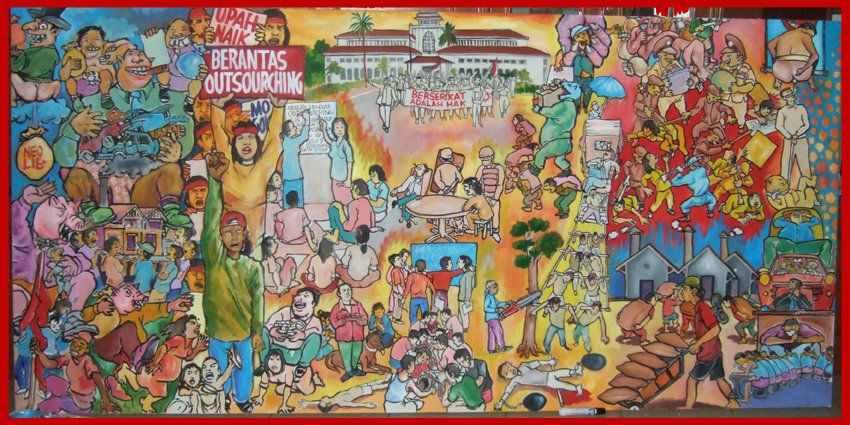Kompas - September 29, 2008
Zely Ariane
”... although legislation represents an important
start, its role cannot be more than just a
beginning. It is political reform that will continue
to be sustainable and must be complimented by
economic, social and cultural reforms -- as a
comprehensive approach for problems that are
likewise comprehensive.” (Sarah Wagner, in Feminism
Changes Society, the Women’s Liberation Struggle in
the Venezuelan Bolivarian Revolution)
start, its role cannot be more than just a
beginning. It is political reform that will continue
to be sustainable and must be complimented by
economic, social and cultural reforms -- as a
comprehensive approach for problems that are
likewise comprehensive.” (Sarah Wagner, in Feminism
Changes Society, the Women’s Liberation Struggle in
the Venezuelan Bolivarian Revolution)
One more legal umbrella has been
added for the advancement of women in Indonesia. Law
Number 2/2008 on Political Parties, which bolsters
the political opportunities for women to take part
in thinking about the direction of the country and
the advance of its people.
The broadening of space for gender mainstreaming has
been realised, but it should not just be restricted
to formal equality in political, professional and
academic circles. It also demands the distribution
of economic justice for women who are poor,
dignified employment and improving knowledge, as
well as affordable, easy and quality education so
that women are no longer just become a reserve of
votes in the name of women representation in
politics.
The 30 percent figure is the minimum limit that has
been agreed to internationally to promote women’s
representation in both parliament as well as public
positions. The campaign for this quota is a form of
the continuing struggle by women following the
achievement of demands for women’s right to vote in
the early 20th Century.
The women’s quota campaign aims to fight the
domestication of women (fighting the politics of
patriarchy) because domestication and male
domination over women under a patriarchal society is
not preordained. But this campaign will not be
completed through women’s representation in the
political parties and parliament.
In principle, this figure should be increased to 50
percent, as is in effect in Cuba and Venezuela,
which will be impossible to achieve if the state
continues to maintain patriarchy as part of its
political system and capitalism as its economic
system.
As an example, the obstacles to the application of
this quota in Indonesia will grow if scholarly
interpretations of religious teachings are not
developed and protected by the state, if illiteracy
is high and if women’s levels of education and
healthcare remain low. This is the source of the low
social capacity of women in Indonesia that must be
overcome, rather than blaming women themselves.
Women are moving from an initial point that is not
on an equal footing with men. Indonesian women have
a higher rate of illiteracy than men and education
levels that are lower then men. It is the mass
political organisations that are capable of becoming
a bridge to increase the awareness and political
knowledge of the majority of women who are the
victims of the feminization of poverty.
The women’s movement
The success of the 1998 democracy movement has made
an extraordinary contribution to the broadening of
women’s organisations. A new challenge is starting
to emerge however -- the spread of these
organisations has not been followed by the
broadening of the women’s (political) movement. This
situation is a consequence of the weak political
position of women in the face of the state so it is
extremely easy for women to be coopted by political
means (particularly the political parties) that are
not really struggling for women’s liberation, but
rather are only “serving up” women in their
leadership structures as a means to increase their
vote.
It is because of this therefore, that the
development and the broadening of the women’s
movement is a key factor in bring about reform.
There will be no reform for women without a women’s
movement. Universal suffrage was won by the first
wave of feminism, including the winning of March 8
as International Women’s Day, along with the
economic, social and cultural rights and civil and
political rights that were won by the second wave of
feminism. The influence of the women’s movement on
the advancement of women’s equality in the world was
huge. Without a movement there will be no progress,
as we are experiencing at the moment.
In Indonesia, Kartini has already laid the basis the
concept of the women’s struggle for liberation, but
this concept was realised and advanced by the
women’s movement of the 1950s and the 1960s era. A
number of advances related to the marriage law, such
as the age limit for the marriage of women and men
along with the freedom to determine one’s life
partner, are the results of women’s movements such
as Istri Sedar (Aware Wives), Gerakan Wanita Sedar
(Women’s Awareness Movement) and Gerakan Wanita
Indonesia (Gerwani, Indonesian Women’s Movement).
This is also the case with the Draft Anti-
Pornography Law which was revised due to the
widespread rejection by the movement.
It is because of this therefore, that formal gains,
such as the birth of various laws that benefit
women, must be seen as legal instruments that must
be based in practice and in a consistent manner
though pressure from the movement in order to
provide the greatest possible benefit to overcoming
the feminization of poverty.
Notes:
Kartini was an Indonesian regent's daughter during
the Dutch colonial period who, through her letters
home, outlined her dreams of a better life for
women. She died aged 25 a few days after giving
birth to her first child. A variety of myths have
made the original Kartini a nationalist hero and
feminist symbol.
[Zely Ariane is the Director of Education and
Literature with the Perempuan Mahardhika
(Independent Women’s) National Network, the
spokesperson of the Peoples Democratic Party-
Political Committee of the Poor (KPRM-PRD) and Hands
Off Venezuela-Indonesia.
Translated by James B


No comments:
Post a Comment